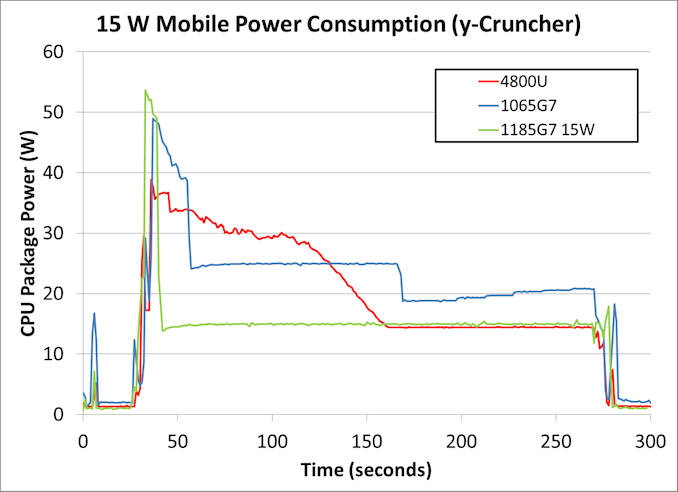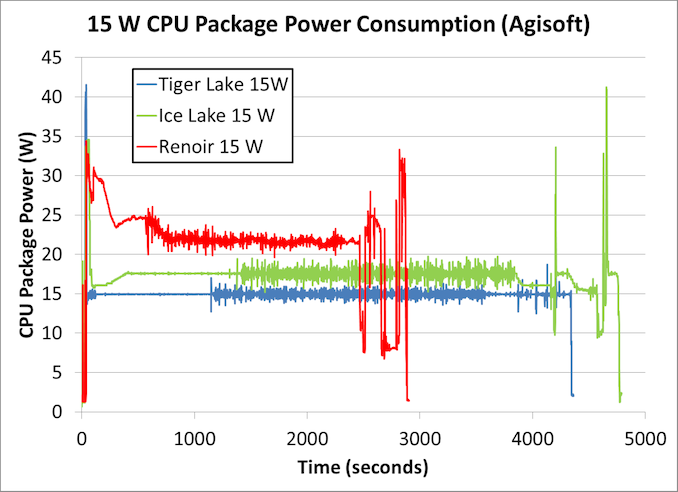Intel’s Tiger Lake 11th Gen Core i7-1185G7 Review and Deep Dive: Baskin’ for the Exotic
by Dr. Ian Cutress & Andrei Frumusanu on September 17, 2020 9:35 AM EST- Posted in
- CPUs
- Intel
- 10nm
- Tiger Lake
- Xe-LP
- Willow Cove
- SuperFin
- 11th Gen
- i7-1185G7
- Tiger King
Comparing 15 W TGL to 15 W ICL to 15 W Renoir
Despite the hullaballoo with the 28 W numbers on Tiger Lake, we suspect that most OEMs will still be positioning the hardware inside chassis built for the 15 W ultraportable market. This is where most of Intel’s OEMs have had success over the last decade, as the lower cooling requirements allow for a more user-friendly design. At 28 W, there is more of a cross-over into laptops that have discrete graphics options, and the main company that has succeeded in offering 28 W laptops without discrete graphics has been Apple - most Intel partners, if they want discrete graphics, end up looking at the 45 W processors with more cores.
So in that respect, our main battle should occur between the products built for 15 W. To that end we have been able to put the three together that will command this holiday season’s offerings: Ice Lake, Tiger Lake, and AMD’s Renoir.
- For our Ice Lake system, we have the Microsoft Surface Laptop 3. This has the top-of-the-line quad-core Core i7-1065G7, along with 16 GB of LPDDR4X-3733. Base 1.3 GHz, Turbo 3.9 GHz. Because this is an OEM design, Microsoft have determined the PL1 and PL2 values, and so they might be different from a ‘base’ design, however this is data from a real system.
- The Tiger Lake system is our Reference Design from Intel, running the quad-core Core i7-1185G7 at 15 W TDP mode. It has 16 GB of LPDDR4X-4266. Base 1.8 GHz, Turbo 4.8 GHz.
- Our AMD Renoir system is one of the most premium examples of AMD’s Ryzen Mobile in a 15W form factor, the Lenovo Yoga Slim 7 with the eight-core Ryzen 7 4800U processor. Even when set to the highest performance mode, the system still operates with a 15 W sustained power draw. It comes equipped with 16 GB of LPDDR4X-4266. Base 1.8 GHz, Turbo 4.2 GHz.
Compute Workload
For our 15 W comparisons, we can look again at the same benchmarks as the previous page. First up is y-Cruncher, an AVX2/AVX512 compute workload that tasks the CPU and the memory by calculating 2.5 billion digits of Pi, and requires ~11 GB of DRAM.
As we saw on the previous page, our Tiger Lake system in green at 15 W turbos up to ~53 watts before very quickly coming down to 15 W for the rest of the test.
The Microsoft Surface Laptop 3, by virtue of an OEM system, has different behavior - it turbos for longer, settles into a short turbo limit of 25 W, and then after about two minutes comes down to 20 W. The system then appears to opportunistically up the power draw until the end of the test, likely due to detecting extra thermal headroom.
The AMD Renoir processor does not turbo as high, peaking at only 38.9 W. Over the course of the next 100 seconds or slow, we see a small ramp down to just under 30 watts, before a more consistent decline over 30 seconds to 15 W, before staying at 15 W for the full test. The Renoir here has eight cores rather that four, but is running AVX2 rather than AVX-512 code.
The results are as follows:
- Ice Lake: 233 seconds, for 6072 joules, averaging 26.1 W
- Tiger Lake: 241 seconds for 4082 joules, averaging 17.0 W
- Renoir: 234 seconds for 5386 joules, averaging 23.0 W
All three systems perform the test in roughly the same amount of time, however the Tiger Lake system is very much ahead for efficiency. Tiger Lake effectively shaves off a third of the power from the previous generation Ice Lake system. We weren’t expecting this much of a jump from Ice Lake to Tiger Lake, but it would appear that Intel has done some work on the AVX-512 unit, and is putting that new high-performance transistor to use.
Professional ISV Workload
Moving onto the Agisoft test - as mentioned on the previous page, this is a 2D image to 3D modeling workflow where the algorithm comes in four stages, some of which prefer full multi-thread throughput, while others are more frequency and memory sensitive.
First, the Renoir finishes in almost half the time, mostly due to the fact that it has double the number of cores - there is no AVX-512 codepath in this test, and so all the processors rely on a mix of SSE, AVX, and perhaps some AVX2. That aside, the turbo behavior of Renoir is very interesting - we get almost 10 minutes of higher-than-base performance before the algorithm sets into a routine, hovering around 22 W. Because this test doesn’t attack the vector units as hard as the previous test, it may be a case that the Renoir system can manage the power distribution a bit better between the eight cores, allowing for the higher turbo.
Between the Ice Lake and the Tiger Lake, from the graph it would appear to be a double win for Tiger Lake, finishing in a shorter time but also consuming less power. The results are:
- 15 W Renoir: 2842 seconds for 62660 joules
- 15 W Ice Lake: 4733 seconds for 82344 joules
- 15 W Tiger Lake: 4311 seconds for 64854 joules
In this case, it’s a win for Renoir - a lot shorter time, and better power to boot, derived from the eight cores built on TSMC 7nm. Tiger Lake still represents a good jump over Ice Lake, offering 10% better performance at only 79% of the power, or a 13% increase in performance efficiency.












253 Comments
View All Comments
ikjadoon - Thursday, September 17, 2020 - link
You wrote this twice without any references, but I'll just write this once:AMD is literally moving to custom Wi-Fi 6 modems w/ Mediatek (e.g., like ASMedia and AMD chipsets): https://www.tomshardware.com/news/report-amd-taps-...
PCIe4: it doesn't need to 'max out' a protocol to be beneficial and likewise allows fewer lanes for the same bandwidth (i.e., PCIe Gen4 also powers the DMI interface now, no?).
Thunderbolt 4 is genuinely an improvement over USB4. Anandtech wrote an entire article about TB4: https://www.anandtech.com/show/15902/intel-thunder... (mandates unlike USB4, 40 Gbps, DMA protection, wake-up by dock, charging, daisychaining, etc). Anybody who's bought a laptop in the past two years know that "USB type-C" is about as informative as "My computer runs an operating system."
AVX512 / DLboost: fair, nobody cares on a thin-and-light laptop.
LPDDR5 is likely coming in 2021 to a Tiger Lake refresh around CES. Open game how many OEMs will wait; noting very few of the 100s of laptop design wins have been released, I suspect many top-tier notebooks will wait.
Billy Tallis - Thursday, September 17, 2020 - link
I'd be surprised if the chipset is using gen4 speeds for the DMI or whatever they call it in mobile configurations. The PCIe lanes downstream of the chipset are all still gen3 speed, so there's not much demand for increased IO bandwidth. And last time, Intel took a very long time to upgrade their chipsets and DMI after their CPUs started offering faster PCIe on the direct attached lanes.JayNor - Saturday, September 19, 2020 - link
4 lanes of pcie4 are on the cpu chiplet, as are the thunderbolt io. They can be used for GPU or SSD.Billy Tallis - Saturday, September 19, 2020 - link
Did you mean to reply to a different comment?RedOnlyFan - Friday, September 18, 2020 - link
Lol this is so uneducated comment. Telling wrong stuff twice doesn't make it correct.Pcie4 implemented properly should consume less power than pcie3.
Thunderbolt 4 is not USB 4. Only tb3 was open sourced to USB 4 so USB 4 will be a subset for tb3 thank Intel for that.
There are more AI/ML used in the background than you realize. If you expect people to do highly multi threaded rendering stuff.. Why not expect AI/ML stuff?
And 2022 is still 1.5 year away. So amd is entering the party after its over.
JayNor - Saturday, September 19, 2020 - link
Thunderbolt 4 doubles the pcie speed vs Thunderbolt 3 that was donated for USB. Intel has also now donated the Thunderbolt 4 spec.Spunjji - Friday, September 18, 2020 - link
They have 4 (four) lanes of PCIe 4.0 - that provides the same bandwidth as Renoir's 8 lanes of 3.0I get that you're one of those posters who just repeats a list of features that Intel has and AMD doesn't in order to declare a "win", but seriously, at least pick one that provides a benefit.
JayNor - Saturday, September 19, 2020 - link
The m.2 pcie4 chips use 4 lanes. Seems like a good combo with Tiger Lake. AMD would need to use up 8 lanes to match it with their current laptop chips.Rudde - Saturday, September 19, 2020 - link
Problem is that there isn't any reasonable mobile pcie4 SSDs yet. Same problem with lpddr5. Tiger Lake will get them when they become available. Renoir was released half a year ago; all AMD based laptops will wait for next gen before adopting these technologies anyway.If you want to argue that AMD is behind, highlight what Ice Lake has, but Renoir doesn't have.
Spunjji - Saturday, September 19, 2020 - link
Why would they bother? There are no performance benefits to using a PCIe 4 SSD in the kinds of systems TGL will go into. You can't get data off it fast enough for the read speed to matter, and it has no effect on any of the applications anyone is likely to use on a laptop that has no GPU. This is aside from Rudde's point about there currently being no products that suit this use case.